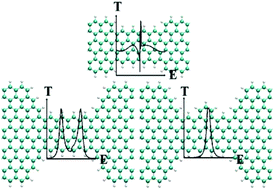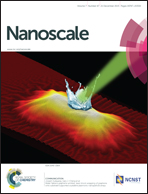Tailoring the transmission lineshape spectrum of zigzag graphene nanoribbon based heterojunctions via controlling their width and edge protrusions†
Abstract
We report a first-principles analysis of electron transport through narrow zigzag graphene nanoribbon (up to 2.2 nm) based wedge-shaped heterojunctions. We show that the width difference between the electrode and the scattering region and the edge protrusion of heterojunctions can be tuned to endow the system's transmission spectrum with distinctive features. In particular, transport through junctions with a one sided protrusion in the scattering region is always dominated by a Breit–Wigner-type resonance right at the Fermi level, regardless of the large or small width difference. On the other hand, a junction with protrusions on both sides of the scattering region shows insulating behaviour near the Fermi level for a large width difference but weak transmission channels are formed at the core of the scattering region for a small width difference. When the protrusion is absent in the junction, transmission functions display rather complex structures: double peaks situating nearly symmetrically away from the Fermi level and a strongly asymmetric profile in the vicinity of the Fermi level are observed for large and small width differences, respectively. These results may shed light on the design of real connecting components in nanocircuits.


 Please wait while we load your content...
Please wait while we load your content...